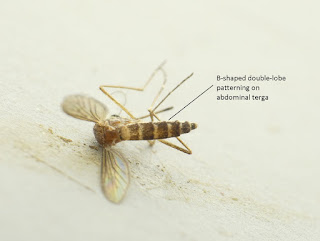Aedes vexans (Meigen 1830), subgenus Aedimorphus.
Common names: Inland Floodwater Mosquito, Common Floodwater Mosquito
 |
| Aedes vexans Photo by author in Richmond County, Georgia |
One of the most abundant and widespread species of mosquito worldwide, Aedes vexans breeds in a plethora of different water body types, but is most common in floodwater pools and ditches. Females lay eggs in shallow pools of water above moist leaves and soil, where the eggs may lay dormant for months after the pool dries before a rain event creates a new puddle for the eggs to hatch and larvae to develop. Quite cosmopolitan, this mosquito is found on every continent except Antarctica and South America and ranges in every state, province, and territory in the USA and Canada. Aedes vexans may be a vector of West Nile, Triple E, and canid heartworm disease. Blood hosts include birds and mammals.
Aedes vexans can be differentiated from other Aedes mosquitoes by the presence of very narrow bands at the base of each tarsal segment. The only other Aedes mosquito in the US and Canada with tarsal banding as narrow is Aedes cantator, which has broad bands on the abdominal terga that connect with the white patches on the sides of the abdomen. The bands on the abdominal terga on Ae. vexans are double-lobed, like a white "B" and do not connect with the patches on the side of the abdomen. The scutum of this species is unpatterned and a dull gray-brown, unlike Aedes cantator which is reddish-brown in coloration. Other mosquitoes that may have narrow tarsal banding are Culiseta sp., which have a blunt abdomen as opposed to the tapered abdomen with exposed cerci that Aedes exhibit.
 |
| Photo by Sergei Drovetski on iNaturalist |
 |
| Photo by David Enrique on iNaturalist |
Sources
Burkett-Cadena, N. D. (2013). Mosquitoes of the Southeastern United States. Tuscaloosa, AL: The University of Alabama Press.
Darsie, R. F., and Ward, W. A. (1981). Identification and Geographical Distribution of the Mosquitoes of North America, North of Mexico. Fresno, CA: American Mosquito Control Association.
Weissmann, M. 2016. Mosquito of the Month: Aedes vexans - the Inland Floodwater Mosquito. Vector Disease Control International, blog post.

